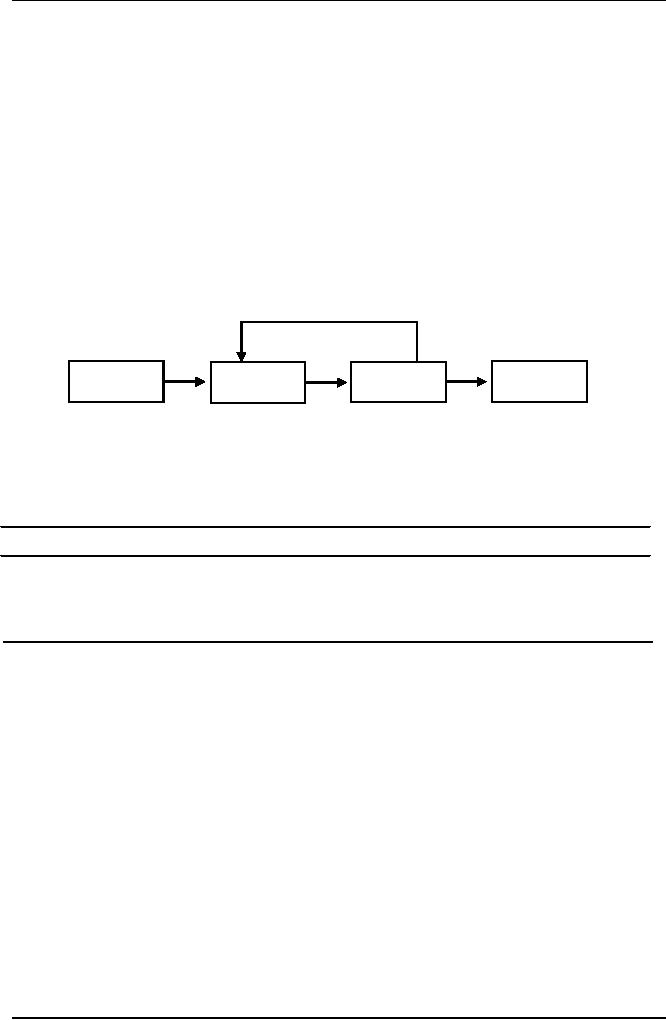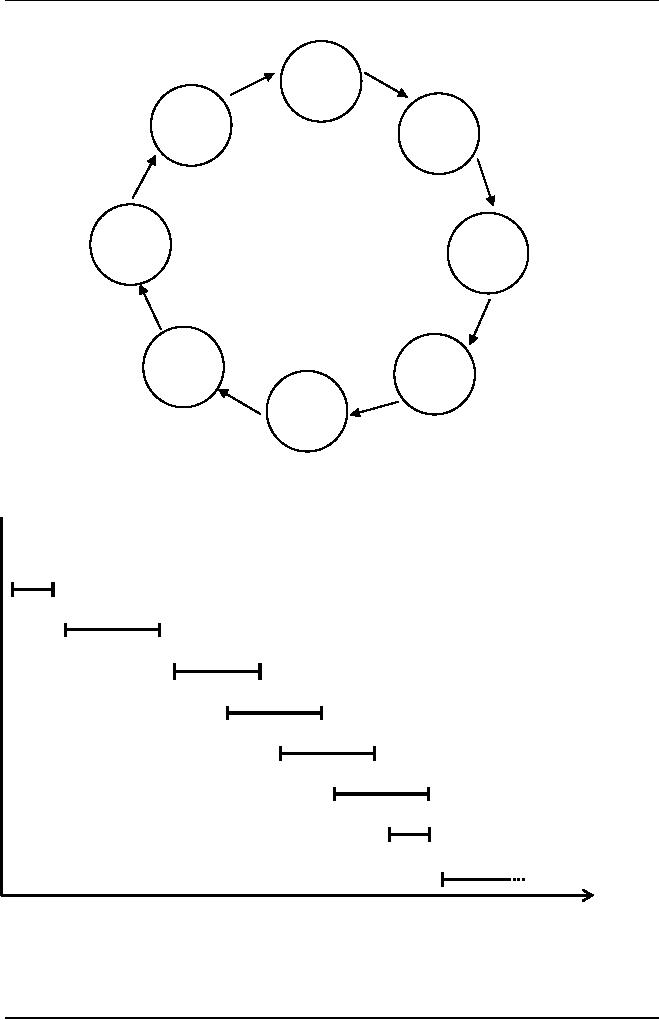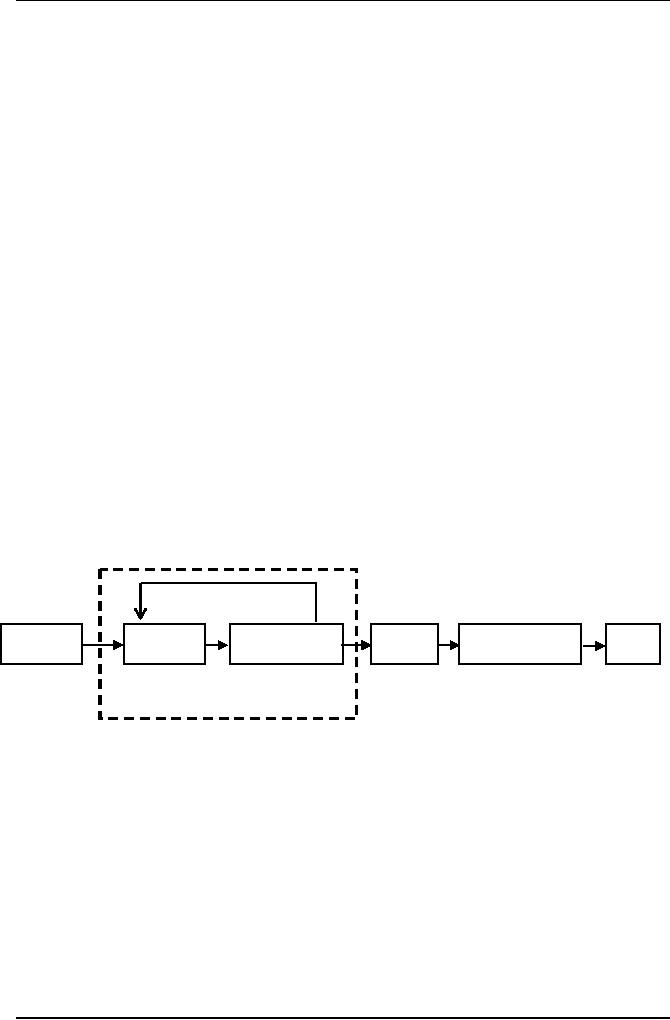 |
Project Dimensions, Software Development Lifecycle |
| << Goals of Project management |
| Cost Management, Project vs. Program Management, Project Success >> |

Software
Project Management
(CS615)
LECTURE
# 3
1.
Introduction &
Fundamentals
1.8
Project
Dimensions
⇒ Product
and Technology
The
80:20, rule was
originated by Vilfredo Pareto, an Italian
economist who
studies
the distribution of wealth in a
variety of countries around
1900. He
discovered
a common phenomenon: about
80% of the wealth in most
countries
was
controlled by a consistent minority --
about 20% of the people.
Pareto called
this a
"predictable imbalance." His
observation eventually became
known as
either
the "80:20 rule" or "Pareto's
Principle."
The
credit for adapting Pareto's
economic observations to business
goes to the
"Father
of Total Quality Management,"
service quality consultant
Joseph M.
Juran. In
1950, he published "The
Quality Control Handbook,"
which first
recognized
the applicability of the
Pareto principle in the
context of inventory
management,
e.g.:
20% of
the repair parts normally
account for 80 percent of
the total
�
inventory
80% of
production volume usually
comes from 20% of the
producers
�
He
subsequently recognized that
this rule of thumb was
universally applicable
across
fields of endeavor. As a credit to
Pareto's work, Juran named
his finding
the
Pareto Principle. This
universal management theory became
generalized as
"the
80-20 Rule":
The
"80:20 rule" has become one
of the best known
"leadership shorthand
terms"
reflecting
the notion that most of
the results (of a life, of a
program, of a financial
campaign)
come from a minority of effort
(or people, or input).
The
Rule, states that a small
number of causes (20%) is
responsible for a
large
percentage
(80%) of the effect. It
means that in anything a few
(20 percent) are
vital and
many (80 percent) are
trivial.
There is
an inherent imbalance between
cause and effect, effort and
reward, inputs
and
outputs, etc; and that
imbalance tends to the ratio of
80:20. So, if we know
which
20% of our work produces 80%
of our income, we can do more of it
and
our
income will increase
proportionately!
11

Software
Project Management
(CS615)
You know
20 percent of you stock
takes up 80 percent of your
warehouse space
and that
80 percent of your stock
comes from 20 percent of
your suppliers. Also
80
percent of your sales will come
from 20 percent of your
sales staff. 20
percent
of your
staff will cause 80 percent of
your problems, but another
20 percent of
your
staff will provide 80 percent of
your production. It works
both ways.
Some
Sample 80/20 Rule
Applications
80% of
process defects arise from
20% of the process
issues.
20% of
your sales force produces
80% of your company
revenues.
80% of
delays in schedule arise
from 20% of the possible
causes of the delays.
80% of
customer complaints arise
from 20% of your products or
services.
How
It Can Help You
The
value of the Pareto
Principle for a manager is that it
reminds you to focus
on
the 20
percent that matters. Of the
things you do during your
day, only 20 percent
really
matter. Those 20 percent
produce 80 percent of your
results. Identify and
Characteristic
focus on
those things. When the fire
drills of the day begin to
sap your time,
remind
yourself of the 20 percent
you need to focus on. If
something in the
schedule
has to slip, if something
isn't going to get done, make sure
it's not part of
that 20
percent.
Pareto's
Principle, the 80/20 Rule,
should serve as a daily reminder to
focus 80
percent
of your time and energy on
the 20 percent of you work
that is really
important.
Don't just "work smart",
work smart on the right
things.
Size
The
larger product, there will be
more requirements and features to
deliver,
eventually
it will take more time in its
production. So if you cut
the size of the
produce
to half it will save you 60%
of the effort.
Characteristic
Development
Tools
12

Software
Project Management
(CS615)
Customer
delivered value
Value of
products
Total
value
Value of
services
+
Personal
value
Real
value to
Image
value
the
customer
-
Financial
cost
Total
costs
Time
cost
Energy
cost
Psychical
cost
1.9
Project
Phases
Organizations
performing projects will usually
divide each project into
several
Project
phases to
improve management control and provide
for links to the
ongoing
operations of the performing
organization.
Collectively,
the project phases are
known as the project
life cycle.
Software
development,
just like most other
activities, has a beginning,
middle and an end.
The end
of one development activity is sometimes
perceived as being linked
to
the
beginning of a new development
activity thus producing a
cycle of beginning-
middle-end,
link, beginning-middle-end, link, and so
forth.
This
view of software development is
referred to as the software
development
life
cycle.
A project
has five phases. Here's a
brief summary of each:
⇒ Initiation
Articulate
your vision for the
project, establish goals,
assemble your team,
and
define expectations and the
scope of your
project.
⇒ Planning
Refine
the scope, identify specific
tasks and activities to be
completed,
and
develop a schedule and
budget.
⇒ Executing
Accomplish
your goals by leading your team,
solving problems, and
building
your project.
13

Software
Project Management
(CS615)
⇒ Controlling
Monitor
changes to the project make
corrections, adjust your
schedule to
respond to
problems, or adjust your
expectations and goals.
⇒ Closing
Deliver
your project to your audience,
acknowledge results, and assess
its
success.
Take the time to compose a
written evaluation of the
project and
the
development effort.
The
middle three phases are
not sequential. You will find
that you are
constantly
planning,
executing, and controlling your
project as necessary.
Aren't
these phases really just
common sense? In many ways,
yes, but keep in
mind
that software development,
whether a few Web pages or a
complex CD-
ROM, is a
complex, unpredictable
process.
Most
software projects (something
like 80 percent) are
delivered late,
substantially
over budget, and incomplete.
The more effort you
put into managing
your
project, the more you
increase your chances of
success.
Characteristics
of Project Phases
Each
project phase is marked by
completion of one or more deliverables.
A
deliverable
is a
tangible, verifiable work
product such as a feasibility
study, a
detail
design, or a working prototype. The
deliverables, and hence the phases,
are
part of a
generally sequential logic
designed to ensure proper definition of
the
product
of the project.
The
conclusion of a project phase is
generally marked by a review of
both key
deliverables
and project performance to date, to a)
determine if the project
should
continue
into its next phase and b)
detect and correct errors cost
effectively. These
phase-end
reviews are often called
phase
exits, stage
gates, or kill
points.
Each
project phase normally
includes a set of defined
deliverables designed to
establish
the desired level of management
control. The majority of
these items are
related
to the primary phase
deliverable, and the phases
typically take their
names
from
these items: requirements, design,
build, test, startup,
turnover, and others,
as
appropriate.
Characteristics
of the Project Life Cycle
The
project life cycle serves to
define the beginning and the
end of a project. For
example,
when an organization identifies an
opportunity to which it would
like to
respond, it will
often authorize a needs
assessment and/or a feasibility
study to
decide if
it should undertake a project.
The project life-cycle
definition will
determine
whether the feasibility
study is treated as the first
project phase or as a
separate,
standalone project.
14

Software
Project Management
(CS615)
The
project life-cycle definition will also
determine which transitional
actions at
the
beginning and the end of the
project are included and
which are not. In
this
manner,
the project life-cycle
definition can be used to link
the project to the
ongoing
operations of the performing
organization.
The
phase sequence defined by
most project life cycles
generally involves
some
form of
technology transfer or handoff
such as requirements to design,
construction
to operations, or design to manufacturing.
Deliverables from the
preceding
phase are usually approved
before work starts on the
next phase.
However,
a subsequent phase is sometimes begun
prior to approval of
the
previous
phase deliverables when the
risks involved are deemed
acceptable. This
practice
of overlapping phases is often
called fast
tracking.
Project
life cycles generally
define:
What
technical work should be done in
each phase (e.g., is the
work of the
architect
part of the definition phase
or part of the execution
phase?).
Who
should be involved in each
phase (e.g., implementers
who need to be
involved
with requirements and
design).
Project
life-cycle descriptions may be
very general or very
detailed. Highly
detailed
descriptions may have
numerous forms, charts, and
checklists to
provide
structure and consistency. Such
detailed approaches are
often called
project
management methodologies.
Most
project life-cycle
descriptions
share
a
number
of
common
characteristics:
Cost and
staffing levels are low at
the start, higher toward
the end, and drop
rapidly
as the project draws to a
conclusion.
The
probability of successfully completing
the project is lowest, and
hence
risk and
uncertainty are highest, at
the start of the project.
The probability of
successful
completion generally gets
progressively higher as the
project
continues.
The
ability of the stakeholders to influence
the final characteristics of
the
project's
product and the final cost of
the project is highest at
the start and
gets
progressively lower as the
project continues. A major
contributor to this
phenomenon
is that the cost of changes and
error correction
generally
increases
as the project
continues.
Care
should be taken to distinguish
the project
life
cycle from the product
life
cycle.
For example, a project
undertaken to bring a new desktop
computer to
market is
but one phase or stage of
the product life
cycle.
Although
many project life cycles
have similar phase names
with similar
deliverables
required, few are identical.
Most have four or five
phases, but some
15

Software
Project Management
(CS615)
have
nine or more. Even within a
single application area,
there can be significant
variations.
One
organization's software development
life cycle may have a
single design
phase
while another's has separate
phases for functional and
detail design.
Subprojects
within projects may also
have distinct project life
cycles. For
example,
an architectural firm hired to design a
new office building is
first
involved
in the owner's definition
phase when doing the design,
and in the
owner's
implementation phase when
supporting the construction
effort. The
architect's
design project, however, will have
its own series of phases
from
conceptual
development through definition and
implementation to closure.
The
architect
may even treat designing
the facility and supporting
the construction as
separate
projects with their own
distinct phases.
Project
Life Cycle includes the following
Phases and activities:
A.
Concept Phase
1. User
Need
2.
Initial Investigation
3. User
Review
4. System
Performance Design
5. Candidate
Review
6. Study
Phase Report
B. Requirements
Phase
1. The
software requirements specification
document
2. The
project development
plan
3. The
software test plan
C.
Design Phase
1.
General System Review
2.
Processing Requirements
Identification
3. Data
Base Design
4.
Control Requirements
5. Output
Design
6. Input
Design
7.
Software Selection
8.
Equipment Selection/Acquisition
9.
People
10.
Reference Manual
Identification
11.
Plans
12.
Design Specifications Preparation
13.
Design Phase Report
Preparation
D. Development
Phase
16

Software
Project Management
(CS615)
1.
Implementation Planning
2.
Computer Program
Design
3. User
Review
4.
Equipment Acquisition and
Installation
5. Coding
and Debugging
6.
Computer Program
Testing
7. System
Testing
8.
Reference Manual
Preparation
9.
Personnel Training
10.
Changeover Plan
Preparation
11.
Development Phase Report
Preparation
12.
User Acceptance
Review
E.
Operation Phase
1. System
Changeover
2.
Routine Operation
3. System
Performance Evaluation
4. System
Changes/Enhancements
1.10
Software
Development Lifecycle
⇒ Water
Fall Theme
Software
development, just like most
other activities, has a
beginning, middle and
an end.
The end of one development activity is
sometimes perceived as being
linked to
the beginning of a new
development activity thus
producing a cycle of
beginning-middle-end,
link, beginning-middle-end, link, and so
forth. This view
of
software development is referred to as
the software development
life cycle.
There
are many variations of the
software development life
cycle. Figure 1
presents
a simple life cycle that was
common during the first
few decades of
software
development. In those early days of
software development,
the
programmer
would create programs by
iterating from code to fix
then back to
code, and
then to fix again, until
something acceptable was (hopefully)
produced.
At the
start of the cycle, there
was usually no clear concept of
what was required,
and the
basic development procedure was a
form of 'let's see what we
can do'
approach.
The
software development method
represented by the development
cycle in Fig.1
is often
referred to as the code and fix
method (for obvious reasons).
Software
development
methodologies have come a long
way since the days of code and
fix,
though it
is surprising how much
software is still being
developed this way.
Successful
management of any project, especially
software projects,
requires
planning,
and planning is impossible with
code and fix, which is
totally
unpredictable.
Management of software development
within an engineering
17

Software
Project Management
(CS615)
discipline
is based on a much more
orderly set of development
phases. These
phases
are not implemented solely
by programmers; they require
software
engineers. In
fact, programming has become
a relatively small part of
the modern
software
development cycle, as is evident
from Table 1.
The
numbers in Table 1 are
derived from the general
shift in emphasis to
software
planning
(requirements and design) and testing.
Commercial data processing
systems,
with some exceptions, still
spend a significant amount of
development
time in
the programming and unit
testing phase. Real-time systems
are often more
complex,
and may include extensive
hardware software integration.
This usually
requires
more planning and more
integration and testing.
Concept
Code
Fix
Maintain
Figure
1: the
code and fix method
Table
1 Estimated
percentage of time spent in each major
software development
phase
Planning
Code
and unit test Integration and
test
Commercial
data processing 25%
40%
35%
Real-time
systems
35%
25%
40%
Military
systems
40%
20%
40%
Military
systems require high reliability and
are usually closely
supervised by the
customer,
leading to a significant increase in
the time spent in
planning.
The
data in Table 1, of course, represents a
generalization; commercial
data
processing systems can
be just as complex as a real-time
system.
Figure 2
presents the basic phased
model of a software development
cycle. This
model,
called the Waterfall model,
gets its name from
the way in which
each
phase
cascades into the next
(due to overlapping), as demonstrated in
Fig. 3.
Some
interpretations of the Waterfall
model, like the one that
follows, combine
the
top level design and the
detailed design phases into a
single design phase, and
the
integration and test phases into a
single phase. In fact, there
are many
variations
of the classic Waterfall model,
but they are all
based upon a
systematic
transition
from one development phase to
the next, until the
project is complete.
18

Software
Project Management
(CS615)
Conception
Maintenance
Software
Requirements
Test
Top
level
Design
Integration
Detailed
Design
Implementation
Figure
2: The
phased model of the software
development life
cycle
Conception
Software
requirements
Top
level" design
Detailed
design
Implementation
Integration
Test
Maintenance
T
Figure
3: The
Waterfall model of the
software development life
cycle
⇒ Rapid
prototyping There
are other development
methodologies that do not
move
from one
phase to the next like
the Waterfall model. Rapid
prototyping, for
19

Software
Project Management
(CS615)
instance,
iterates in a mini-development phase
until a system prototype
is
developed
(see Fig. 4). After
the prototype is complete,
the Waterfall approach
can then
be implemented to complete the full
system. Rapid prototyping
is
particularly
helpful in projects where
the requirements are
difficult to specify.
The
prototype
can be used as a tool for
analyzing and determining what
the
requirements
should be.
⇒ The
Spiral model,
described by Boehm (1988), is
another development
method
that
iterates between the requirements, design
and implementation phases.
However,
the Spiral model continues
iterating until the final
system is complete.
Within
each, iteration, the Spiral
model follows a phased approach
similar to the
Waterfall
model.
Different
models maybe suitable for
different software projects or
for different
software
development organizations However, a good
model must include
certain
fundamental
features. Some of these
basic requirements are
discussed in IEEE
Standard
(IEEE 1993) Standard for
Software Life Cycle
Processes. This standard
describes
the processes that are
mandatory for the
development of software and
specifies
the activities that must be
included in the life cycle
model.
Most
modern software development
models, and certainly those following
IEEE
Standard
1074, include some form of
the basic phased model. It
is therefore
important
to understand the different
phases and how they relate
to one another.
Concept
Prototype
Requirements
Design
Implementation
Test
The
rapid prototyping
cycle
Figure
4: Rapid
prototyping followed by the
phase method.
20
Table of Contents:
- Introduction & Fundamentals
- Goals of Project management
- Project Dimensions, Software Development Lifecycle
- Cost Management, Project vs. Program Management, Project Success
- Project Management’s nine Knowledge Areas
- Team leader, Project Organization, Organizational structure
- Project Execution Fundamentals Tracking
- Organizational Issues and Project Management
- Managing Processes: Project Plan, Managing Quality, Project Execution, Project Initiation
- Project Execution: Product Implementation, Project Closedown
- Problems in Software Projects, Process- related Problems
- Product-related Problems, Technology-related problems
- Requirements Management, Requirements analysis
- Requirements Elicitation for Software
- The Software Requirements Specification
- Attributes of Software Design, Key Features of Design
- Software Configuration Management Vs Software Maintenance
- Quality Assurance Management, Quality Factors
- Software Quality Assurance Activities
- Software Process, PM Process Groups, Links, PM Phase interactions
- Initiating Process: Inputs, Outputs, Tools and Techniques
- Planning Process Tasks, Executing Process Tasks, Controlling Process Tasks
- Project Planning Objectives, Primary Planning Steps
- Tools and Techniques for SDP, Outputs from SDP, SDP Execution
- PLANNING: Elements of SDP
- Life cycle Models: Spiral Model, Statement of Requirement, Data Item Descriptions
- Organizational Systems
- ORGANIZATIONAL PLANNING, Organizational Management Tools
- Estimation - Concepts
- Decomposition Techniques, Estimation – Tools
- Estimation – Tools
- Work Breakdown Structure
- WBS- A Mandatory Management Tool
- Characteristics of a High-Quality WBS
- Work Breakdown Structure (WBS)
- WBS- Major Steps, WBS Implementation, high level WBS tasks
- Schedule: Scheduling Fundamentals
- Scheduling Tools: GANTT CHARTS, PERT, CPM
- Risk and Change Management: Risk Management Concepts
- Risk & Change Management Concepts
- Risk Management Process
- Quality Concept, Producing quality software, Quality Control
- Managing Tasks in Microsoft Project 2000
- Commissioning & Migration